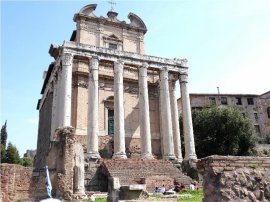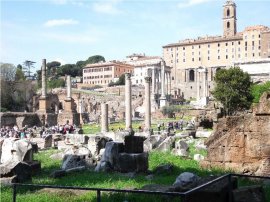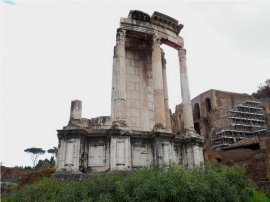Famous buildings in History
 The Colosseum (or Coliseum) was started by Vespasian (AD 9 - 79) on becoming emperor in 69 AD. It was built on the site of Neros Golden Palace in order to give the land back to the people having been acquired by Nero following the great fire of Rome in 64 AD when the previous amphitheatre was destroyed. Vespasian never saw the amphitheatre completed as he died in 79 AD. It fell to his sons, Titus and then Domitian to complete the project.
The Colosseum (or Coliseum) was started by Vespasian (AD 9 - 79) on becoming emperor in 69 AD. It was built on the site of Neros Golden Palace in order to give the land back to the people having been acquired by Nero following the great fire of Rome in 64 AD when the previous amphitheatre was destroyed. Vespasian never saw the amphitheatre completed as he died in 79 AD. It fell to his sons, Titus and then Domitian to complete the project.
Rome is about 2600 years old, and during this time, layers of buildings and roads have accumulated, with many ancient buildings to be found underneath modern day ones. The Square around the Colosseum, however, is at the same level as it was in ancient times.
When it was first built, the Colosseum was surrounded by an area paved with large travertine slabs with boundary stones set in the ground. A Colossal statue of Nero, which stood by his palace was retained and it was that which gave it its name although its correct name was the Flavian Amphitheatre - after the Flavian dynasty of Vespasian, Titus and Domitian.
The building itself is elliptical in shape, 187 metres long by 155 metres across and 50 metres high. It originally consisted of three floors with the attic being added later by Domitian. It consisted of 240 external arches with 76 used as entrances. These were numbered, and determined the entrance to be used by each ticket holder. This enabled an efficient circulation of the 50, 000 to 70, 000 people it could accommodate and provided swift access and egress - calculated to be approximately 30mins - and it kept the different classes of spectators separated.
The arena is 75 metres by 44 metres with the floor made of timber. This was covered with yellow sand which is called harena in Latin, which is where we get the word arena. The spectators were seated in tiers above the arena according to class, with the higher social classes nearer the arena. A fence was place on the podium with wooden rollers on top, in order to prevent anything from climbing over from the arena.
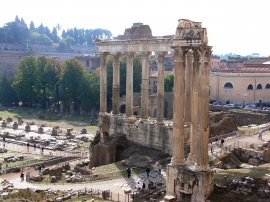 When first constructed, the floor could be removed, allowing the arena to be flooded for sea battles called a naumachia; later Domitian added a complex of stores and holding rooms which were constructed on two floors and known as the hypogeum (meaning underground) which brought an end to the naumachia. Animals and gladiators would be kept in the hypogeum until they were required in the arena when they would be lifted into the arena by a series of elevators, or guided up ramps. The hypogeum was connected by underground tunnels to a number of points outside the Colosseum in order to be able to bring in the animals, gladiators and the condemned without them having to use the streets around the Colosseum.
When first constructed, the floor could be removed, allowing the arena to be flooded for sea battles called a naumachia; later Domitian added a complex of stores and holding rooms which were constructed on two floors and known as the hypogeum (meaning underground) which brought an end to the naumachia. Animals and gladiators would be kept in the hypogeum until they were required in the arena when they would be lifted into the arena by a series of elevators, or guided up ramps. The hypogeum was connected by underground tunnels to a number of points outside the Colosseum in order to be able to bring in the animals, gladiators and the condemned without them having to use the streets around the Colosseum.
The construction of the Colosseum involved the draining of the lake constructed by Nero and was achieved due to a number of technical innovations in architecture and construction developed by the Romans. These were the arch, concrete and mass production of bricks. It used a number of construction materials to maximise their qualities, these were travertine, tufa, brickwork and cement. The project required vast resources, much of which came from the sacking of the Temple in Jerusalem.
The games themselves lasted all day, the morning entertainment was the hunt, where animals were hunted and killed; in many cases with the use of elaborate scenery. Midday was when the condemned were executed and the afternoon was the gladiatorial combat.
During the games spectators would be protected from the sun by an awning which was secured to poles passing through sockets at the top of the building and supported on rests built into the walls. The awning was controlled by a unit of sailors of the imperial fleet.
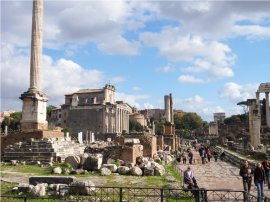 The Colosseum became known as the arena of death due to the number of animals and people who died there in the name of entertainment. The Inaugural games lasted 100 days with thousands of animals being required. The Colosseum remained in service for four and a half centuries with the last gladiatorial combat in 404 AD and the last hunt in 523 AD.
The Colosseum became known as the arena of death due to the number of animals and people who died there in the name of entertainment. The Inaugural games lasted 100 days with thousands of animals being required. The Colosseum remained in service for four and a half centuries with the last gladiatorial combat in 404 AD and the last hunt in 523 AD.
The Forum
The area of the Forum was originally a grassy wetland of approximately 250 x 170 metres between the Palatine and Capitoline Hill. As more people began to settle in the area during the 7th century BC a large covered sewer system was constructed in order to drain the area into the River Tiber. In time it developed into an open air market near the Comitium (a place of political and judicial activities). Over the years a number of buildings were constructed and in 600 BC the area was paved. This was the first forum and was considered ancient Rome's city centre. As Rome's population increased, the forum became too small and in 46 BC Julius Caesar built a new one, setting a precedent that was followed by successive emperors including Augustus and Trajan whose forums are adjacent to this one, although a main road separates them and partly covers some of the ruin, work that was carried out by Mussolini in the 1930s.
The forum was initially a market-place that was also used for festivals and for conducting business. Over time, many of the traditions from the Comitium such as the popular assemblies, funerals of the nobility and games were transferred to the Forum. All the important buildings of Rome were located in or near this area. These include the royal residency of the Regia and the complex of the Vestal Virgins. The Senate House, government offices, Tribunals, religious monuments, memorials and statues could all be found there. Eventually the judicial offices and the senate itself moved from the Comitium to the Forum, which became the city square and the economic and political hub of the Roman Empire.
As with many ancient buildings, a great deal of the building material has been removed from the Forum to be used elsewhere, so apart from a few buildings and the arches of Titus (opposite the Colosseum) and Septimius Severus only columns and stone blocks remain.
When visiting the Forum, the first building to be seen on entry is the Temple of Antonious and Fustina situated on the left as you walk in. This temple was begun in 141 AD by the Emperor Antoninus Pius, and was initially dedicated to his deceased wife, Faustina. After Antoninus Pius died in 161 AD, his successor, Marcus Aurelius...

